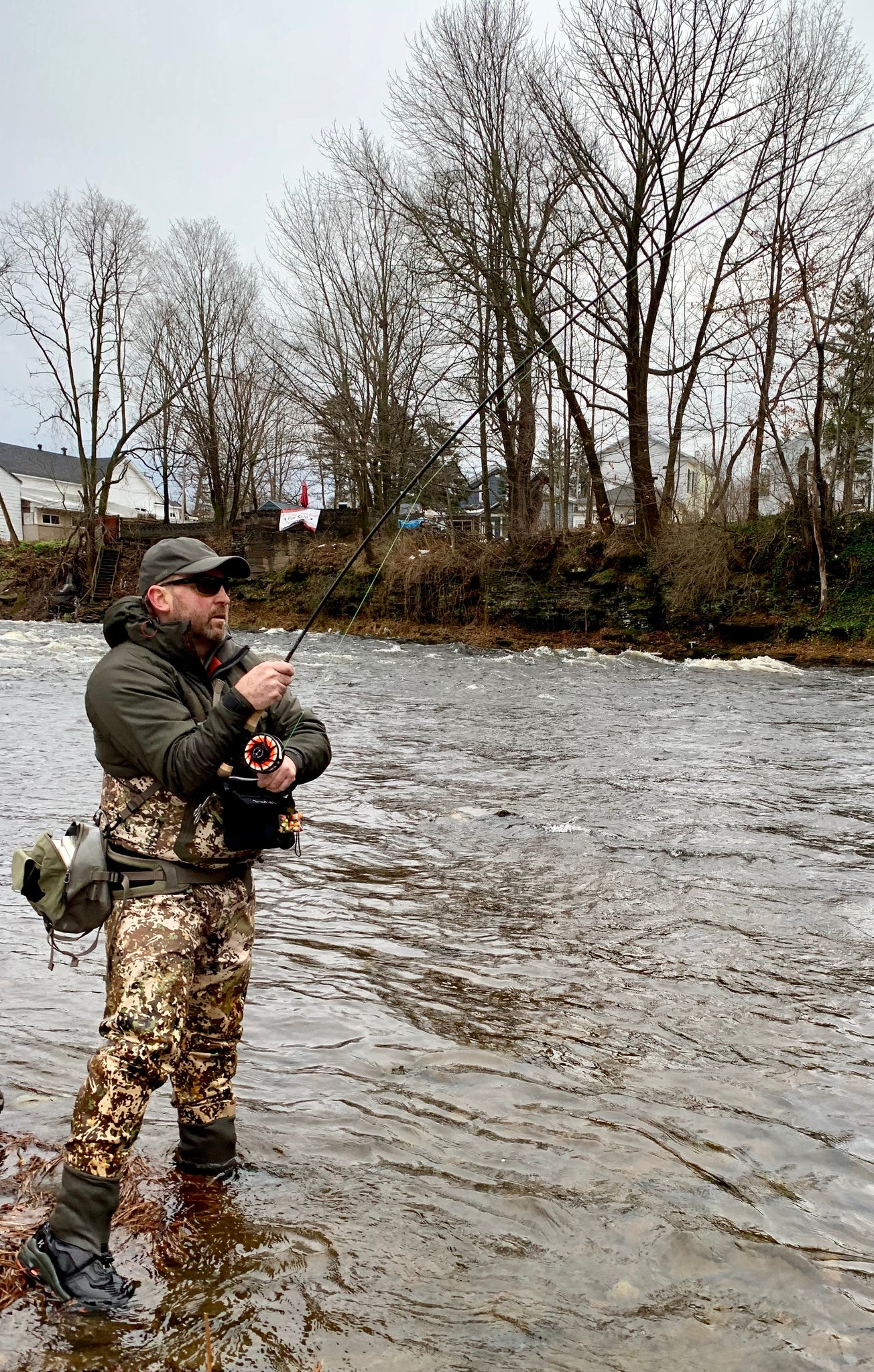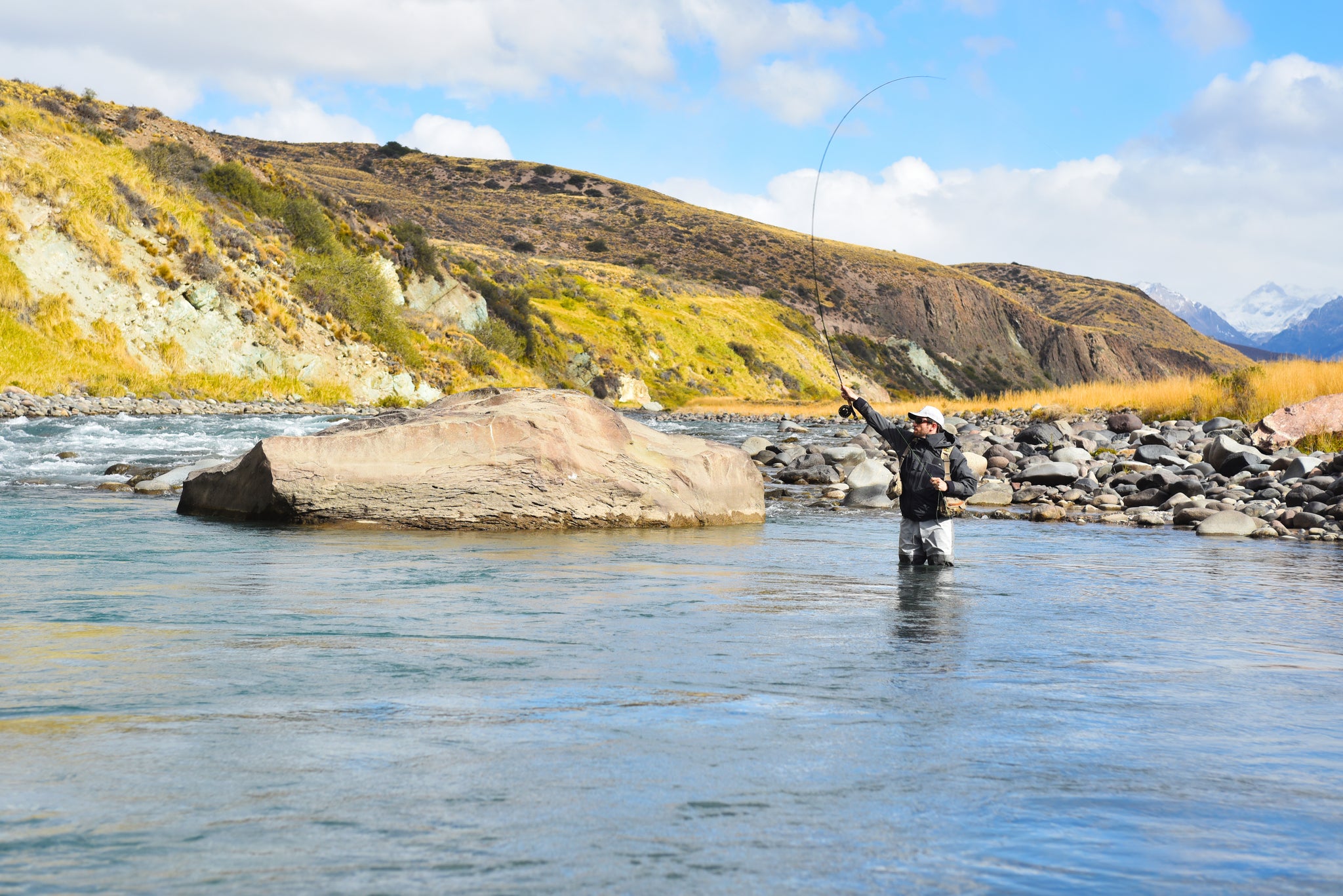I’ve been fishing for Great Lakes Steelhead for well over 30 years now. My friend Fred Clason introduced me to the Salmon River in NY and to Fran Verdoliva, the first fly fishing Steelhead guide on that river. Fran took me under his wing and taught me how to catch Steelhead/Pacific Salmon/Lake Run Browns, and I ultimately ended up guiding two seasons for him in the Salmon River area right after college.
Back then, the big fly fishing innovation was fishing long, light rods with thin running/shooting lines that allowed us to fish further away (thinner line = less weight = less sag & better contact) and dead drift flies in fast water with enough split shot to get down where the Steelhead held. We built our own custom fly rods from 10 1/2’ noodle rods, and then fished .029-.031” running lines rigged with 10-15’ leaders and some brightly colored Amnesia tied into them to help track our drifts and detect light strikes. Other than the split shot and single fly (only one fly is allowed on NY Great Lakes tributaries), it was quite similar to modern day European Nymphing set-ups, and it was lethally effective for catching highly pressured steelhead in water that traditional fly fishing methods could not touch. It also allowed us to fish lighter tippets when necessary, and still have the ability to land big fish without breaking them off. Back then we mainly fished Maxima Chameleon in 4-6# test (which FYI tests out higher than it’s labeled).
Fast forward to 2018. Longer rods are the norm, fluorocarbon tippet has mostly replaced nylon monofilament, and switch rods in 11+ feet are popular. Some fishermen fish even longer traditional Spey rods with Skagit or Scandi heads & swing flies, some Indicator fish, and many tight line nymph/bottom bounce. All methods work, but the most consistent of all on pressured fish in fast water is a tight line/dead drift presentation of egg patterns, attractor flies, and nymphs. I had moved to switch rods for tight lining and indicator nymphing due to their greater length for better line control, but they are a bit clunky and heavy compared to a one-hander.
Enter the T&T Contact 10’ 8” #6 (1086). This rod feels as light as a feather due to its very low swing weight. What that means is the balance point is closer to your hand than on other rods that length, so you don’t need an extra heavy reel to balance your outfit like on most other long rods. Two rods can have the same physical weight, but the one with a lower swing weight will feel much lighter and be more pleasant to fish. The blank is made with T&T’s proprietary StratoTherm construction, which makes for a very light & very strong rod. A lighter rod blank equates to more sensitivity, better casting, faster recovery, less tip bounce, less arm/shoulder fatigue, and just a more pleasant feel and fishing experience. My Hatch Finatic 5 Plus mid arbor at a little over 6 oz balanced my rod beautifully about 1.5” back from the front end of the rod grip, but you could probably use a reel that’s up to an ounce lighter than that.
Joe Goodspeed played a large role in the design, and he worked closely with expert guide & outfitter Lance Wilt for input during the design process. Joe swung by UpCountry Sportfishing and put this rod in my hands in July, and I was impatient for the fall season to arrive and excited because I knew him to be a seasoned Great Lakes tributary fisherman who knows what success requires from your equipment on those often challenging fisheries. I now have two steelhead trips to the Salmon River in NY under my belt on this rod, and I have to say I’m very impressed. This rod was purpose-built for tight line/dead drift presentations, and it excels at that. Whether you use a fly line and a 10-15’ leader for high sticking, or a mono rig for the ultimate tight line presentation, this rod casts effortlessly, is super sensitive to light bites, sets the hook well, and protects the tippet while still allowing you to put the wood to bigger fish.
The tip is very light and has plenty of flex to allow easy short casting, it cushions your tippet and helps keep you hooked up to a leaping & head shaking fish. The lower half of the rod blank looks very thin, and it is, but it has plenty of power to land a truly big steelhead with no problems. This rod was specifically designed to be extra durable and hold up to the abuse that fishing for steelhead, lake run brown trout, and big landlocked salmon can dish out. It handled a fat 31” steelhead that was easily 12lb+ on my last trip, that fish took me through heavy rapids, and the Contact 1086 landed him in a matter of several minutes. Local Farmington river guide and T&T Pro Zach St. Amand landed both landlocked salmon & lake run browns up to 31" recently with no problem whatsoever. I know Joe Goodspeed has landed multiple Steelhead well over 30” on the 1086, as well as some really big wild browns in South America on the Chile/Argentina border.
The rod handle is full wells and reinforced on each end with a synthetic composite. The hardware is beefed up compared to the trout models in the Contact series, including a larger fighting butt that comes in handy when your forearm fatigues while playing a big fish. The ceramic stripping guide has a titanium frame, and the other guides are all virtually unbreakable titanium RECoil single foot guides. FYI single foot guides keep the weight down due to half as many wraps to cover with epoxy, and the RECoil guides can be flicked/snapped with your fingertip to pop ice off them, and they snap right back into place without bending. This is a big plus when fishing in below freezing temps, which is quite common when pursuing Great Lakes Steelhead, I wish all fly rods had RECoil guides.
Despite the 1086 being designed specifically for tight line/dead drift Euro style presentations (which it excels at), I also found it to be surprisingly versatile; it’s not a one trick pony. I put a Royal Wulff #6 Triangle Taper on it, which is my favorite fly line for Great Lakes tributary fishing. It has a long continuous taper that allows you to high stick with a thinner line out your rod tip, instead of a thicker fly line that creates a belly/sag and bad presentations. When I combined the T&T Contact 1086 with the Triangle Taper, standard overhead casts, roll casts and one handed Spey casts, they were all easy to execute.
Swinging a Bugger with a split shot using a one handed Spey cast was no problem, and the rod mended line easily. I built a leader with a two-tone butt section with 2’ of 20# red Amnesia down to 2’ of 15# green Amnesia (or sub your favorite .012-.014’ sighter material) with a medium 2.5mm tippet ring, and then I had 6-8’ (you can shorten for fishing up close in pocket water or smaller, shallower streams) of 1x Cortland Ultra Premium fluorocarbon tippet (it’s the absolute best fluorocarbon on the market, hands down), tied to a micro barrel swivel (with tag end left about 3” long to put split shot on, overhand knot in the end to keep shot from slipping off too easily), and then 12-24” of fluorocarbon tippet, typically 2x-3x. The long piece of 1x tippet sinks your flies faster due to less friction than a thicker leader, and it also allows you to fish less split shot (I learned the long/thin tippet trick from years of Euro nymphing for trout).
I’d feel comfortable fishing this rod with 1x-5x tippet, that would equate to approximately 12# down to 4# tippet. I try to fish the heaviest terminal tippet I think I can get away with- it’s easier on the fish, it saves you flies, and you spend more time fishing and less re-rigging. However, my favorite line set-up was a mono rig using 25# green OPST Lazar line as my main line. I then put a 2-4’ of a 12-15# step-down section on the end, to a 24” section of Cortland bicolor Sighter Material in .012-.014”. A medium 2.5mm tippet ring goes on the bottom of the sighter, and then typically 7-8’ of 1x fluorocarbon as in the rig previously described with a micro barrel swivel on the end and 1-2’ of tippet off that.
This rig is easy to throw on the 1086, and it allows you to make tight line drifts at a long distance when necessary, without the belly/sag that standard fly line creates on longer casts. I feel that the mono rig is more sensitive to light bites, due to the weight reduction by eliminating the fly line. This is further amplified by the light & sensitive tip on the Contact 1086. FYI if you are fishing in either the Upper or Lower Fly Zones on the Salmon River in NY, you have to use fly line (no running/shooting/Euro lines) and no more than 15 feet of leader (as measured from the end of the fly line to your fly). The mono rig is perfectly legal on the rest of the river.
My verdict? This rod is the best I’ve used for tight line presentations to steelhead, period, but is surprisingly versatile. It can swing flies, overhead cast, roll cast, and even one hand Spey cast. It works with a fly line or a mono rig and would also work well with running/shooting lines. It tight lines like a champ, but will swing flies and Indicator fish well too. A lot of my customers asked me last fall for a “Euro” style steelhead rod, and now they finally have it, and so much more. It will handle hefty steelhead, large lake run browns, and bigger landlocked salmon on a wide range of tippet sizes & presentations. Don’t let the thin rod blank and low swing weight fool you into thinking this rod is a toy- the power & sensitivity are impressive, and it will more than withstand what this type of fishing can dish out. Two thumbs up T&T!




